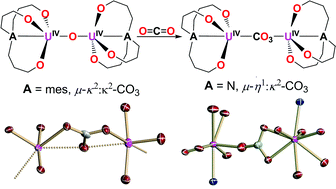Insights into the mechanism of carbonate formation through reductive cleavage of carbon dioxide with low-valent uranium centers†
Abstract
The low-valent

* Corresponding authors
a
Department of Chemistry and Pharmacy, Inorganic Chemistry, University Erlangen-Nuremberg, Egerlandstraße 1, D-91058 Erlangen, Germany
E-mail:
karsten.meyer@chemie.uni-erlangen.de
b University of California, San Diego, Department of Chemistry and Biochemistry, 9500 Gilman Drive, La Jolla, USA
The low-valent

 Please wait while we load your content...
Something went wrong. Try again?
Please wait while we load your content...
Something went wrong. Try again?
O. P. Lam, S. C. Bart, H. Kameo, F. W. Heinemann and K. Meyer, Chem. Commun., 2010, 46, 3137 DOI: 10.1039/B927142B
To request permission to reproduce material from this article, please go to the Copyright Clearance Center request page.
If you are an author contributing to an RSC publication, you do not need to request permission provided correct acknowledgement is given.
If you are the author of this article, you do not need to request permission to reproduce figures and diagrams provided correct acknowledgement is given. If you want to reproduce the whole article in a third-party publication (excluding your thesis/dissertation for which permission is not required) please go to the Copyright Clearance Center request page.
Read more about how to correctly acknowledge RSC content.
 Fetching data from CrossRef.
Fetching data from CrossRef.
This may take some time to load.
Loading related content
